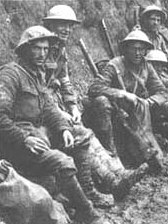Infantry
|
|

Infantry are soldiers who fight primarily on foot (although in modern times they often use motorised, mechanized, or even airborne transportation). Traditionally, they have used personal weapons, but modern infantry invariably operate with attached support weapons and sometimes armored fighting vehicles.
| Contents |
History of Infantry pre-Industrialisation
With a few notable exceptions, most armies in history have been structured around a core of infantry. While the specific weapons have varied, the constant variable has been that these soldiers have relied on their own two feet for transportation and tactical movement. Among the most famous historical examples of infantry units are those of the phalanxes of ancient Greece and the legions of Imperial Rome. The size of these formations could reach several thousand men. The phalanx eventually gave way to the legion because of the legion's greater tactical mobility, elucidating a trend in the history of warfare: speed and mobility have always vied with armor for tactical superiority. While each side has had its periods of success, it can generally be said that, even in the case of infantry, speed has won out.
In contrast to the obsessively-organized, well-equipped phalanxes and legions, most armies of the ancient world also employed units of so-called skirmishers (often mercenaries or slaves) who often wore minimal armor and carried an eclectic mix of weapons ranging from swords and javelins to slings and bows. It is important to note that, for the most part, the contemporary social atmosphere placed great emphasis on the honor of hand-to-hand combat, leading to a greater emphasis placed upon units such as the phalanx and legion at the expense of otherwise-equipped troops. This attitude would evolve by the Middle Ages.
Large, well-disciplined units of infantry were common to the wars of the ancient world. However, as the Roman Empire declined and fell to the depredations of Germanic tribes such as the Vandals, the Goths, and the Visigoths in the 5th century AD, the political and military resources necessary for the maintenance of such units by and large disappeared until the later Middle Ages with the appearance of the large bureaucratic systems associated with the monarchical nation-states.
For most of the Middle Ages, warfare and society were dominated by the glamor of horse cavalry, expressed at the time in the form of knights. For a more detailed discussion of the socio-political significance of such an emphasis, follow the previous link. For the purposes at hand, however, it will suffice to say that knights were generally formed from the aristocracy, while the infantry levies were drawn from the common-folk or peasants. This led to a stagnation of the technologies and tactics that would improve the effectiveness of the infantry. However, some tactics were seen to be very effective. Infantry often took up long spears or halberds to counter the long reach of knights' lances. It also became more and more common for infantry to carry ranged weapons, as these would also effectively nullify the cavalry's advantage of momentum, speed, height, and reach. By the late Middle Ages, these tactics were crystallizing.
While bows remained in use long after the development of firearms, technological fine-tuning (along with the development of the wheellock) allowed firearms to supersede even the feared English longbow as the ranged weapon of choice for infantry. The bow also declined in favor due to the ease with which musketeers could be trained (days or weeks to attain moderate proficiency, as opposed to many years for the longbow).
Many nations combined firearms with extremely long pikes into units that were virtually invincible against cavalry formations. Eventually, with the development of the bayonet, the pikemen were dropped from the formation, resulting in the first examples of an infantry unit as recognizable today.
History of Infantry post-Industrialisation to Today
Before the development of railroads in the 19th century, infantry armies got to the battlefield by walking, or sometimes by ship. In the 1890s and later, some countries used bicycle infantry, but the real revolution in mobility started in the 1920s with the use of motor vehicles, resulting in motorised infantry. Action in World War II demonstrated the importance of protecting the soldiers while they are moving around, resulting in the development of mechanized infantry that uses armoured vehicles for transport. World War II also saw the first widespread use of airborne or parachute infantry, which played key roles in several campaigns in the European theater. During the Vietnam conflict, the US Army pioneered the use of helicopters to deliver large numbers of infantry quickly to and from key locations on the battlefield.
Modern-day infantry is supported by armoured fighting vehicles, artillery, and aircraft, but are still the only kind of military force that can take and hold ground, and thus remain essential to fighting wars.
Quotations
- "I love the infantry because they are the underdogs. They are the mud-rain-frost-and-wind boys. They have no comforts, and they even learn to live without the necessities. And in the end they are the guys that wars can't be won without." Ernie Pyle
- "I'm convinced that the infantry is the group in the army which gives more and gets less than anybody else." Bill Mauldin, Up Front (1945)
See also
- Army
- Combat Infantryman Badge
- Marine
- Military history
- Military science
- Mobile infantry
- The Military Revolution
- Zouave
- See List of Regiments of Foot for the numbered British Army infantry regiments of the 18th and early 19th centuries. For British infantry regiments by year, see: 1881, 1962, 1994bg:Пехота
cs:Pěchota da:Infanteri de:Infanterie es:Infantería fr:Infanterie it:Fanteria he:חיל רגלים nl:Infanterie ja:歩兵 pl:Piechota pt:Infantaria sl:Pehota zh:步兵
